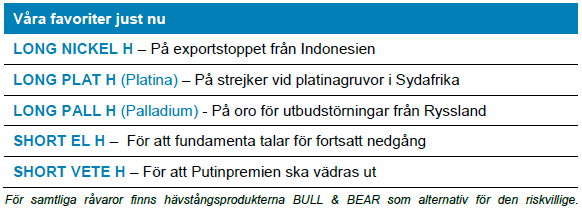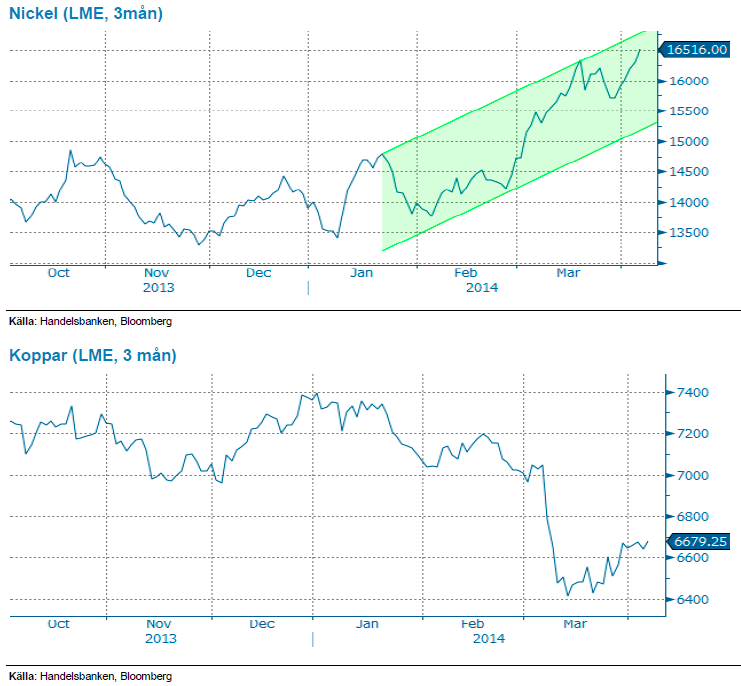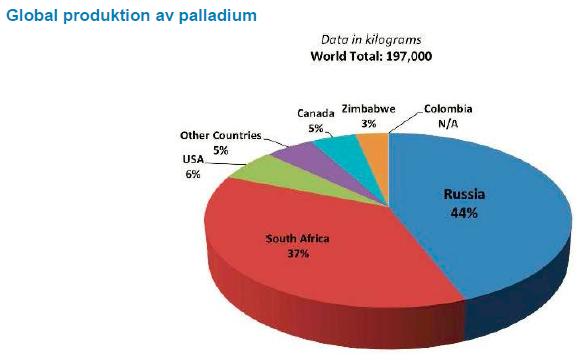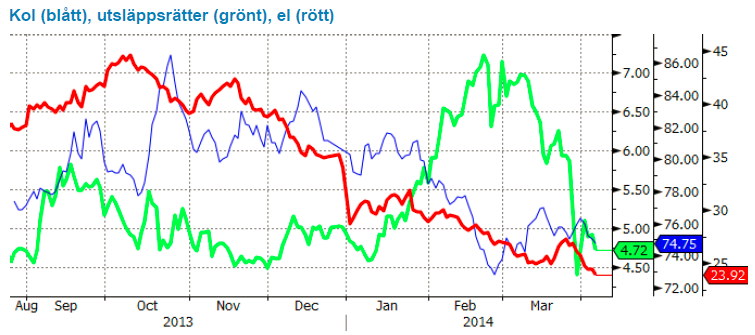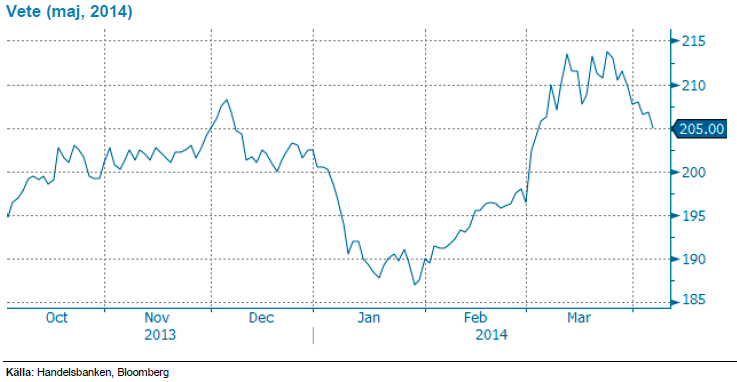Analys
SHB Råvarubrevet 4 april 2014

Råvaror allmänt: Dataintensiv vecka bekräftar global motvind
 Efter en viktig och tung datavecka står det klart att nedgången i början av året i USA inte enbart kan härledas till den kalla vintern. En lägre aktivitet än under slutet av förra året ska nu prisas in. I Kina fortsätter data att försämras.
Efter en viktig och tung datavecka står det klart att nedgången i början av året i USA inte enbart kan härledas till den kalla vintern. En lägre aktivitet än under slutet av förra året ska nu prisas in. I Kina fortsätter data att försämras.
Inköpschefsindex var visserligen snäppet bättre än under februari men ska normalt vara mycket starkare under mars och april som sparkar igång årets mest intensiva period i Kinesisk industri. Tar man hänsyn till det så fortsätter nedgången i den kinesiska dataströmmen.
Oljemarknaden tog till sig den svaga amerikanska inköpschefssiffran och föll snabbt 2 dollar under tisdagen. Under onsdagen gick sedan oljan till årslägst och under 105 USD efter att rebellerna i Libyen var nära en överrenskommelse om att öppna hamnarna för oljeexport igen. Vi har argumenterat för att oljan står inför sin svagaste period på året och att återkomsten av Iraq och Libyen kan göra årets svacka djupare än vanligt. Annars har råvarumarknaden inte reagerat nämnvärt på svag makrodata från Kina. Vi tror att förklaringen är att investerare redan är korta kinarelaterade råvaror vilket minskar rörelserna på nedsidan och förstärker rekyler uppåt. Marknaden har spekulerat tungt i att det ska komma stimulanser från kinesiska ledare, i veckan kom ministimulanser som inte är någon ”game changer”. Vi tror att det är inprisat en spänning i kinarelaterade råvaror, speciellt koppar, där eventuellt uteblivna stimulanser kan komma att leda till ytterligare en nedgång.
Amerikanska sysselsättningssiffror – vilka marknaden väntat på med spänning – kom in i linje med förväntningarna (192 000 nya jobb), En något högre arbetslöshet gjorde dock att räntorna kom ned en del, och marknaden ser för sig en längre period av QE. En mix som borde gynna riskaptiten!
Basmetaller: Nickel fortsätter att imponera
Under veckan har vi konkretiserat vår vy på nickel Trading Case på nickel. Nickel har under veckan stigit ytterligare 5 % och hittills i år har metallen stigit 18 %. Vi tror nickel kommer befinna sig i en stigande trend under hela året och bedömer den största risken som utgången av valet i Indonesien. Presidentval hålls i juli men vi tror att oavsett utgång av valet kommer Indonesien behålla exportförbudet fram till raffinaderierna är utbyggda under första halvåret 2015. Läs hela caset här.
Koppar har klarat sig någorlunda bra denna vecka efter ett tungt första kvartal. Data visar att investerar nu är rekordkorta koppar vilket gör att marknaden känslig för short covering (när investerare köper tillbaka sålda kontrakt). Vi är fortsatt något negativa till utvecklingen för metallen men bättre makrodata från USA, (lite) stimulans från Kina och korta investerare ger stöd till priset.
Till sist meddelades i förra veckan att den regelförändringen som LME skulle införa den 1 april i år, för att korta leveranstiderna från börsens lager, blir lagd på is.
Ädelmetaller: Guldet laddar för Fed-möte
Två veckor har gått sedan förra brevet då vi beskrev reaktionerna på Federal Reserves något mer hökaktiga kommunikation som väldigt viktiga för guldpriset. Sedan Janet Yellen började tala om räntehöjningar har guldet tappat drygt 2,5 %, men hela veckan har priset legat stilla. Vi handlar ganska nära topparna, men den senast tidens inflöden i ETF-marknaden har avstannat.
Sammantaget befinner sig guldet i ett ganska känsligt läge, och nästa Fed-möte är drygt tre veckor bort. Amerikanska räntor, vilka steg rejält efter Fed-mötet ligger kvar på sina högsta-nivåer, vilket indikerar att marknaden är rädd för ytterligare hökaktiga besked. Vi behåller vår positiva syn på guld, men anser fortfarande att man bör ”dansa nära nödutgången”, och vara ödmjuk om priset börjar falla igen. Konsensus-synen på guld är fortfarande negativ, vilket gör att man kan spela ”motvalls” genom att ligga lång eller köpa guld, och skulle Fed visa sig vara mindre hökaktig vid nästa möte (29-30 april) borde vi kunna ta ny fart uppåt igen. Rörelserna fram till dess kommer att ge mer signaler på hur marknaden positionerar sig.
Vi noterar att både platina (+/- 0) och palladium (+3 %) har klarat Fed-retoriken avsevärt bättre än guldet, delvis med stöd av oron över Ryssland-Ukraina. Ryssland är världens största producent av palladium.
Mot bakgrund av risken för utbudsstörningar från Ryssland, och guldets större räntekänslighet, sätter vi nu palladium som en av våra favoriter, då vi fortfarande är positiva till ädelmetaller generellt.
Energi: Elpriset ser svagt ut
Elmarknaden faller med närmare 7 procent under veckan och vi står fast vid vy att det kan finnas ytterligare några euro kvar på nedsidan för kvartalet Q3 2014 (nedan i rött indexerat ett år tillbaka). Det finns egentligen ingen faktor som pekar uppåt sett till energibalansen som bör landa på svagt plus under den kommande veckan, utsläppsrätter som förra veckan föll över 20 procent på utsläppsrapporten för 2013 (vilken påtvingade en del stoppar, se nedan i grönt) samt kol som faller med ytterligare en dollar.
Lägg därtill en ganska svag tysk marknaden och fortsatt press på gaspriset. Det enda som egentligen kan störa bilden något är Ringhals 1 som förväntas vara igång den 11e juni igen där det verkar finnas ovanligt stor risk för försening men i övrigt pekar det mesta ned. Med detta som grund har vi valt SHORT EL H som en annan av våra favoriter just nu.
Livsmedel: Vete väntas falla ytterligare
Med regnet tillbaka i Brasilien har kaffeterminerna fallit tillbaka från två-årshögsta och handlas sedan två veckor tillbaka inom intervallet 1.70-1.80 dollar/Ib. Vi bibehåller vår neutrala vy då situationen i de kaffeproducerande regionerna ser ut att ha stabiliserats. Dock kvarstår spekulationer om storleken på bortfallet för årets skörd, vilket vi följer med spänning. Efter en kortare mognadsperiod på grund av torkan under utblomningsperioden, väntas nu skörden starta tidigare än normalt.
Extrem torka i området kring Elfenbenskusten låg bakom förra årets höga kakaopriser. I år väntas goda skördar efter hittills gynnsamt väder i viktiga kakaoregioner med visst undantag för Indonesien där väder och svampangrepp varit en utmaning. På sikt ser vi dock risk på uppsidan då varmare och torrare klimat över normalen väntas i samband med El Niño. En studie från ICCO visar på vilka effekter som El Niño haft på den globala kakaoproduktionen de senaste 60 åren, där framförallt Indonesien och Ecuador tagit mest stryk.
Priset på vete har gått ned 2,2 % under veckan, inte minst till följd av att det amerikanska höstvetet äntligen fått lite mer regn, mer önskas men helt klart har situationen lindrats. Dessutom ser det ut att komma mer regn under nästa vecka. Ukraina har nu fått en del skurar, vilket bara gynnar då det i vissa områden varit lite torrt. Höstvetet i Ukraina uppges vara i gott skick och vårsådden är i stort sett avklarad utan problem. Ryssland ser nästa vecka ut att få lite varmare väder – vilket gynnar både höstvetet och snabbar på starten av vårsådden. I Australien har det kommit en del regn, främst i landets östra delar, vilket tar bort en del av oron inför kommande sådd. Generellt sett är de höstsådda grödorna alltså i ett gott skick på det norra halvklotet, det största problemet har varit torkan för det amerikanska höstvetet – vilket dock fortfarande oroar men i alla fall lindrats. Problemen i Ukraina lever än men vetesådden har inte drabbats och än så länge inte heller majssådden och priserna ligger kvar på en klart högre nivå jämfört med innan konflikten startade. Givet att inget mer allvarligt sker i Ukraina/Ryssland kommer marknaden nu fokusera mer på väder och utsikter för ny skörd – vilket än så länge ser lovande ut. Vi placerar SHORT VETE H som en av våra favoriter just nu.
Handelsbankens råvaruindex (USD)
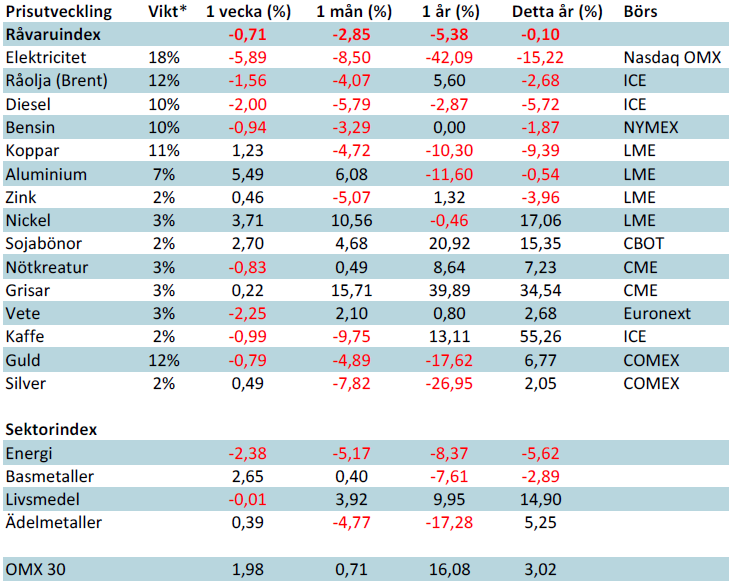
*Uppdaterade vikter från 29 november 2013
Handelsbankens råvaruindex består av de underliggande indexen för respektive råvara. Vikterna är bestämda till hälften från värdet av nordisk produktion (globala produktionen för sektorindex) och till hälften från likviditeten i terminskontrakten.
[box]SHB Råvarubrevet är producerat av Handelsbanken och publiceras i samarbete och med tillstånd på Råvarumarknaden.se[/box]
Ansvarsbegränsning
Detta material är producerat av Svenska Handelsbanken AB (publ) i fortsättningen kallad Handelsbanken. De som arbetar med innehållet är inte analytiker och materialet är inte oberoende investeringsanalys. Innehållet är uteslutande avsett för kunder i Sverige. Syftet är att ge en allmän information till Handelsbankens kunder och utgör inte ett personligt investeringsråd eller en personlig rekommendation. Informationen ska inte ensamt utgöra underlag för investeringsbeslut. Kunder bör inhämta råd från sina rådgivare och basera sina investeringsbeslut utifrån egen erfarenhet.
Informationen i materialet kan ändras och också avvika från de åsikter som uttrycks i oberoende investeringsanalyser från Handelsbanken. Informationen grundar sig på allmänt tillgänglig information och är hämtad från källor som bedöms som tillförlitliga, men riktigheten kan inte garanteras och informationen kan vara ofullständig eller nedkortad. Ingen del av förslaget får reproduceras eller distribueras till någon annan person utan att Handelsbanken dessförinnan lämnat sitt skriftliga medgivande. Handelsbanken ansvarar inte för att materialet används på ett sätt som strider mot förbudet mot vidarebefordran eller offentliggörs i strid med bankens regler.
Analys
Tightening fundamentals – bullish inventories from DOE

The latest weekly report from the US DOE showed a substantial drawdown across key petroleum categories, adding more upside potential to the fundamental picture.

Commercial crude inventories (excl. SPR) fell by 5.8 million barrels, bringing total inventories down to 415.1 million barrels. Now sitting 11% below the five-year seasonal norm and placed in the lowest 2015-2022 range (see picture below).
Product inventories also tightened further last week. Gasoline inventories declined by 2.1 million barrels, with reductions seen in both finished gasoline and blending components. Current gasoline levels are about 3% below the five-year average for this time of year.
Among products, the most notable move came in diesel, where inventories dropped by almost 4.1 million barrels, deepening the deficit to around 20% below seasonal norms – continuing to underscore the persistent supply tightness in diesel markets.
The only area of inventory growth was in propane/propylene, which posted a significant 5.1-million-barrel build and now stands 9% above the five-year average.
Total commercial petroleum inventories (crude plus refined products) declined by 4.2 million barrels on the week, reinforcing the overall tightening of US crude and products.


Analys
Bombs to ”ceasefire” in hours – Brent below $70

A classic case of “buy the rumor, sell the news” played out in oil markets, as Brent crude has dropped sharply – down nearly USD 10 per barrel since yesterday evening – following Iran’s retaliatory strike on a U.S. air base in Qatar. The immediate reaction was: “That was it?” The strike followed a carefully calibrated, non-escalatory playbook, avoiding direct threats to energy infrastructure or disruption of shipping through the Strait of Hormuz – thus calming worst-case fears.

After Monday morning’s sharp spike to USD 81.4 per barrel, triggered by the U.S. bombing of Iranian nuclear facilities, oil prices drifted sideways in anticipation of a potential Iranian response. That response came with advance warning and caused limited physical damage. Early this morning, both the U.S. President and Iranian state media announced a ceasefire, effectively placing a lid on the immediate conflict risk – at least for now.
As a result, Brent crude has now fallen by a total of USD 12 from Monday’s peak, currently trading around USD 69 per barrel.
Looking beyond geopolitics, the market will now shift its focus to the upcoming OPEC+ meeting in early July. Saudi Arabia’s decision to increase output earlier this year – despite falling prices – has drawn renewed attention considering recent developments. Some suggest this was a response to U.S. pressure to offset potential Iranian supply losses.
However, consensus is that the move was driven more by internal OPEC+ dynamics. After years of curbing production to support prices, Riyadh had grown frustrated with quota-busting by several members (notably Kazakhstan). With Saudi Arabia cutting up to 2 million barrels per day – roughly 2% of global supply – returns were diminishing, and the risk of losing market share was rising. The production increase is widely seen as an effort to reassert leadership and restore discipline within the group.
That said, the FT recently stated that, the Saudis remain wary of past missteps. In 2018, Riyadh ramped up output at Trump’s request ahead of Iran sanctions, only to see prices collapse when the U.S. granted broad waivers – triggering oversupply. Officials have reportedly made it clear they don’t intend to repeat that mistake.
The recent visit by President Trump to Saudi Arabia, which included agreements on AI, defense, and nuclear cooperation, suggests a broader strategic alignment. This has fueled speculation about a quiet “pump-for-politics” deal behind recent production moves.
Looking ahead, oil prices have now retraced the entire rally sparked by the June 13 Israel–Iran escalation. This retreat provides more political and policy space for both the U.S. and Saudi Arabia. Specifically, it makes it easier for Riyadh to scale back its three recent production hikes of 411,000 barrels each, potentially returning to more moderate increases of 137,000 barrels for August and September.
In short: with no major loss of Iranian supply to the market, OPEC+ – led by Saudi Arabia – no longer needs to compensate for a disruption that hasn’t materialized, especially not to please the U.S. at the cost of its own market strategy. As the Saudis themselves have signaled, they are unlikely to repeat previous mistakes.
Conclusion: With Brent now in the high USD 60s, buying oil looks fundamentally justified. The geopolitical premium has deflated, but tensions between Israel and Iran remain unresolved – and the risk of missteps and renewed escalation still lingers. In fact, even this morning, reports have emerged of renewed missile fire despite the declared “truce.” The path forward may be calmer – but it is far from stable.
Analys
A muted price reaction. Market looks relaxed, but it is still on edge waiting for what Iran will do

Brent crossed the 80-line this morning but quickly fell back assigning limited probability for Iran choosing to close the Strait of Hormuz. Brent traded in a range of USD 70.56 – 79.04/b last week as the market fluctuated between ”Iran wants a deal” and ”US is about to attack Iran”. At the end of the week though, Donald Trump managed to convince markets (and probably also Iran) that he would make a decision within two weeks. I.e. no imminent attack. Previously when when he has talked about ”making a decision within two weeks” he has often ended up doing nothing in the end. The oil market relaxed as a result and the week ended at USD 77.01/b which is just USD 6/b above the year to date average of USD 71/b.

Brent jumped to USD 81.4/b this morning, the highest since mid-January, but then quickly fell back to a current price of USD 78.2/b which is only up 1.5% versus the close on Friday. As such the market is pricing a fairly low probability that Iran will actually close the Strait of Hormuz. Probably because it will hurt Iranian oil exports as well as the global oil market.
It was however all smoke and mirrors. Deception. The US attacked Iran on Saturday. The attack involved 125 warplanes, submarines and surface warships and 14 bunker buster bombs were dropped on Iranian nuclear sites including Fordow, Natanz and Isfahan. In response the Iranian Parliament voted in support of closing the Strait of Hormuz where some 17 mb of crude and products is transported to the global market every day plus significant volumes of LNG. This is however merely an advise to the Supreme leader Ayatollah Ali Khamenei and the Supreme National Security Council which sits with the final and actual decision.
No supply of oil is lost yet. It is about the risk of Iran closing the Strait of Hormuz or not. So far not a single drop of oil supply has been lost to the global market. The price at the moment is all about the assessed risk of loss of supply. Will Iran choose to choke of the Strait of Hormuz or not? That is the big question. It would be painful for US consumers, for Donald Trump’s voter base, for the global economy but also for Iran and its population which relies on oil exports and income from selling oil out of that Strait as well. As such it is not a no-brainer choice for Iran to close the Strait for oil exports. And looking at the il price this morning it is clear that the oil market doesn’t assign a very high probability of it happening. It is however probably well within the capability of Iran to close the Strait off with rockets, mines, air-drones and possibly sea-drones. Just look at how Ukraine has been able to control and damage the Russian Black Sea fleet.
What to do about the highly enriched uranium which has gone missing? While the US and Israel can celebrate their destruction of Iranian nuclear facilities they are also scratching their heads over what to do with the lost Iranian nuclear material. Iran had 408 kg of highly enriched uranium (IAEA). Almost weapons grade. Enough for some 10 nuclear warheads. It seems to have been transported out of Fordow before the attack this weekend.
The market is still on edge. USD 80-something/b seems sensible while we wait. The oil market reaction to this weekend’s events is very muted so far. The market is still on edge awaiting what Iran will do. Because Iran will do something. But what and when? An oil price of 80-something seems like a sensible level until something do happen.
-

 Nyheter4 veckor sedan
Nyheter4 veckor sedanUppgången i oljepriset planade ut under helgen
-

 Nyheter3 veckor sedan
Nyheter3 veckor sedanMahvie Minerals växlar spår – satsar fullt ut på guld
-

 Nyheter4 veckor sedan
Nyheter4 veckor sedanLåga elpriser i sommar – men mellersta Sverige får en ökning
-

 Nyheter2 veckor sedan
Nyheter2 veckor sedanOljan, guldet och marknadens oroande tystnad
-

 Analys4 veckor sedan
Analys4 veckor sedanVery relaxed at USD 75/b. Risk barometer will likely fluctuate to higher levels with Brent into the 80ies or higher coming 2-3 weeks
-

 Nyheter2 veckor sedan
Nyheter2 veckor sedanJonas Lindvall är tillbaka med ett nytt oljebolag, Perthro, som ska börsnoteras
-

 Analys3 veckor sedan
Analys3 veckor sedanA muted price reaction. Market looks relaxed, but it is still on edge waiting for what Iran will do
-

 Nyheter2 veckor sedan
Nyheter2 veckor sedanDomstolen ger klartecken till Lappland Guldprospektering


